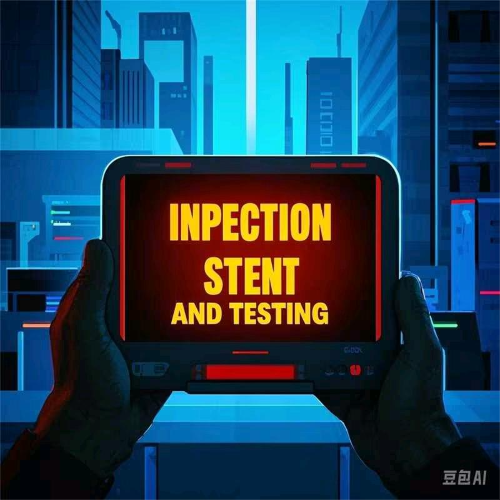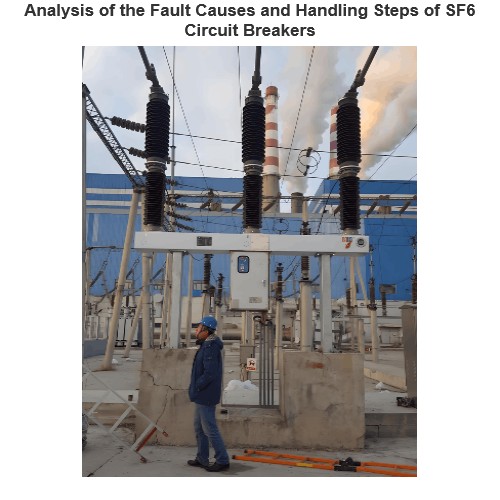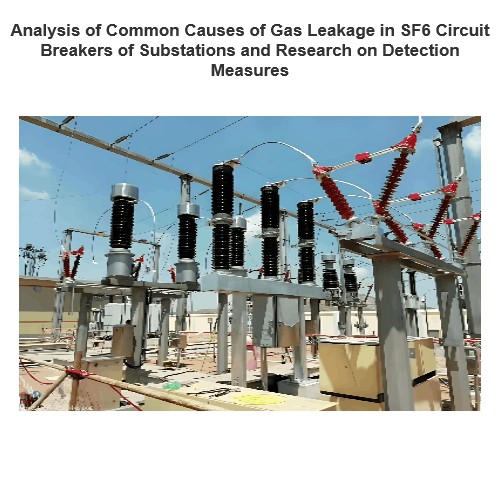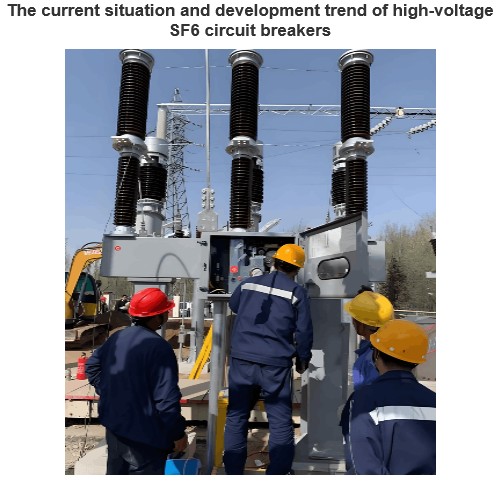Research on Fault Analysis and Handling Methods of SF6 Circuit Breakers

Oliver Watts
05/08/2025
In the substation system, high - voltage circuit breakers are power - interrupting devices, among which SF₆ circuit breakers are the most common. Such circuit breakers use SF₆ gas as the main insulating medium. Based on the action of arc energy, SF₆ compressed gas is formed to instantly extinguish the arc, thus achieving the interruption of rated current and fault current, protecting power - cutting lines and electrical equipment from damage. The system is equipped with a complete operating system, which can control the circuit breaker through opening and closing operations, and has strong functionality.
SF₆ circuit breakers are crucial for the normal operation of substations. Once an SF₆ circuit breaker malfunctions, it will directly affect the operation of each substation system. This shows the importance of the maintenance and protection work for SF₆ circuit breakers. In such an environmental context, exploring the fault analysis and treatment methods of SF₆ circuit breakers has important practical significance.
1 Analysis of Common Faults of SF₆ Circuit Breakers
1.1 Insufficient SF₆ Gas Pressure
1.1 Insufficient SF₆ Gas Pressure
During the actual operation of SF₆ circuit breakers, the situation of insufficient SF₆ gas pressure is likely to occur. Once this fault occurs, the pressure value on the SF₆ pressure gauge will be lower than the rated pressure value. In remote control, the background management system will issue an alarm to remind the management personnel that the SF₆ gas pressure is too low.
This phenomenon is mainly caused by the low ambient temperature in the area where the SF₆ circuit breaker is located, or there is a gas leakage in the SF₆ system, or the pressure gauge reading is incorrect, resulting in a failure of the SF₆ density relay, which in turn causes insufficient SF₆ gas pressure and leads to the failure of the SF₆ circuit breaker.
1.2 Failure of SF₆ Circuit Breaker to Close or Open
During the operation of the SF₆ circuit breaker, after the opening and closing commands are issued under manual operation, the SF₆ circuit breaker does not respond, thus causing the failure of the SF₆ circuit breaker to close or open.
The root causes of this fault problem mainly include three aspects. First, the spring energy - storage system fails and cannot provide energy and power for the opening and closing operations of the SF₆ circuit breaker. Second, the control circuit is blocked, resulting in an open circuit and hindering the transmission of opening and closing commands. Third, there is a mechanical linkage failure. Even if the command is transmitted, due to the failure or damage of mechanical components, the issued command cannot be completed.
1.3 False Opening Fault of SF₆ Circuit Breaker
The false opening fault is one of the common faults of SF₆ circuit breakers. It mainly refers to the situation where the SF₆ circuit breaker automatically opens without an operation command, making the SF₆ circuit breaker out of control and affecting the normal operation of the substation.
The reasons for this fault phenomenon are mainly human misoperation or accidental touch. It may also be caused by false opening due to external mechanical vibration. Electrical faults can also lead to the automatic opening of the SF₆ circuit breaker, mainly due to incorrect protection actions and incorrect setting values. During the two - point grounding of the DC system, after the positive and negative power supplies are connected, the relay protection signal is transmitted and received, resulting in incorrect actions. In addition, mechanical faults such as the failure of the closing bracket to support or the displacement of the positioning screw may also cause the false opening fault of the SF₆ circuit breaker.
1.4 False Closing Fault of SF₆ Circuit Breaker
The false closing fault is one of the common faults of SF₆ circuit breakers. It refers to the situation where the SF₆ circuit breaker automatically closes without an operation command, making the SF₆ circuit breaker out of control and affecting the normal operation of the substation.
The reasons for this fault phenomenon are mainly that the positive and negative contacts in the DC circuit are not connected but grounded simultaneously, forming a closing control circuit, thus causing a closing fault; the resistance of the closing contactor coil is small, reducing the starting voltage, causing a momentary pulse in the DC system and forming a closing fault; and the damage of the opening latch support can also cause the false closing fault of the SF₆ circuit breaker.
2 Treatment Methods for SF₆ Circuit Breaker Faults
2.1 Treatment Method for Insufficient SF₆ Gas Pressure Fault
2.1 Treatment Method for Insufficient SF₆ Gas Pressure Fault
Once the insufficient SF₆ gas pressure fault occurs, the maintenance personnel should first record the pressure gauge value of the SF₆ circuit breaker regularly and convert it into the pressure value at the standard temperature to determine whether the gas pressure in the SF₆ circuit breaker is normal. If the pressure continues to drop, it is diagnosed as a gas leakage in the SF₆ circuit breaker.
After charging the SF₆ circuit breaker to the rated pressure, observe the change of the pressure gauge. Use an SF₆ leak detector to check all parts of the SF₆ circuit breaker, including connecting parts, sealing rubber rings, and the position of the pressure gauge joint. According to the actual situation, soapy water can be applied to the suspected leakage parts to determine the leakage location.
During leakage treatment, carry out repair welding on the leakage parts. Replace the leaking and damaged parts according to the usage of each part. In practice, since the density relay failure can also cause the system to issue a low - pressure alarm, the maintenance personnel can further check the density relay, especially for the indicator light and switch parts, to rule out the situation of switch adhesion or short - circuit, and replace the damaged relay in time to eliminate the fault.
2.2 Treatment Method for Failure of SF₆ Circuit Breaker to Close or Open Fault
In the case of the failure of the SF₆ circuit breaker to close or open, the fault should be eliminated according to the specific cause of the failure.
For the failure of the SF₆ circuit breaker to close or open caused by the failure of the spring energy - storage system, the maintenance personnel should check the operation of the auxiliary switch and energy - storage motor of the spring energy - storage system, and replace the components with burnt - out marks on the outer surface in time. If the appearance is normal, remove the motor wires and test whether the resistance of the energy - storage motor and the auxiliary switch can work normally. If the energy storage is normal after closing and the motor keeps running, it is determined that the energy - storage auxiliary switch cannot disconnect the circuit in time due to reasons such as moisture - induced adhesion or contact burnout, thus causing the failure of the SF₆ circuit breaker. The maintenance personnel should manually disconnect the energy - storage power switch to prevent the components from being burnt out due to the long - term operation of the motor, replace the auxiliary switch, check whether the entire equipment is affected by moisture or water seepage, and take timely moisture - proof and seepage - proof measures to prevent the recurrence of the SF₆ circuit breaker failure.
For the failure of the SF₆ circuit breaker to close or open caused by the blockage of the control circuit, the maintenance personnel should first check the working state of the opening and closing coils of the circuit breaker, check whether the control wires are broken, and rule out the looseness or disconnection of the wiring terminals and auxiliary switch nodes. First, the maintenance personnel should check whether the opening and closing coils are overheated or burnt out, and replace the damaged opening and closing coils in time. Second, according to the wiring diagram of the SF₆ circuit breaker, use a multimeter to check the connectivity of the circuit breaker circuit, and timely rule out the situation of broken wires or loose connections to ensure that the locking circuit is normal. Once an abnormality occurs, the fault point can be immediately determined and the fault can be eliminated.
For the failure of the SF₆ circuit breaker to close or open caused by mechanical linkage failure, the maintenance personnel should stop using the SF₆ circuit breaker and report the mechanical failure to the superior leader. Generally, mechanical failures include problems such as mechanism jamming, loose opening latch, and detachment of the transmission connecting rod. The maintenance personnel should disassemble the mechanically faulty components, restore the original mechanical components to their original positions according to the factory instruction manual, replace the damaged mechanical components, clean the dust on the components, add appropriate lubricating oil, and eliminate the mechanism jamming problem to achieve fault elimination.
2.3 Treatment Method for False Opening Fault of SF₆ Circuit Breaker
For the false opening fault caused by human misoperation or accidental touch, the maintenance personnel should first check the signal display of the SF₆ circuit breaker, rule out the switch fault, and restart the SF₆ circuit breaker to supply power. For the false opening fault caused by electrical faults, the maintenance personnel should first check the signal and setting value of the SF₆ circuit breaker, find the fault point, analyze the cause of the fault, and timely eliminate and repair the faulty components. For the components that are affected by moisture due to poor sealing, replace the sealing components and install a heating device for moisture - proof and dehumidification to eliminate the fault problem. For the false opening fault caused by mechanical faults, the maintenance personnel should disassemble the mechanical part, re - correct the position of the positioning screw, replace or repair the closing bracket, eliminate the false opening fault, and thus ensure the normal operation of the SF₆ circuit breaker.
2.4 Treatment Method for False Closing Fault of SF₆ Circuit Breaker
In the treatment of the false closing fault of the SF₆ circuit breaker, the maintenance personnel should clarify the main cause of the false closing fault of the SF₆ circuit breaker and adopt targeted treatment methods to eliminate the fault. The maintenance personnel should regularly check the moisture - proof situation of each component of the SF₆ circuit breaker. If the closing is caused by the simultaneous grounding of the positive and negative contacts in the DC circuit and it is judged that it is caused by the moisture of the secondary circuit, a moisture - proof and dehumidification device can be installed in the moisture - affected parts, and the water - seepage holes can be blocked in time to eliminate the fault. At the same time, the maintenance personnel should check all secondary circuits, replace the defective or damaged components in time, and eliminate the fault. In addition, the maintenance personnel should check the opening latch component, replace the damaged opening latch component, and eliminate the fault.
3 Case Analysis
3.1 Fault Phenomenon
3.1 Fault Phenomenon
A LW15 - 252 type SF₆ circuit breaker was put into operation as early as 2007. After the circuit breaker tripped, the latch was still in an over - position, and there was an abnormal spacing of about 10mm between the latch and the closing trigger, with abnormal contact. However, after the closing pulse power supply was provided, the coil and the trigger worked normally, but the latch still could not be disengaged for closing. After manually disengaging the latch, the switch still could not close.
3.2 Fault Analysis
Through the analysis of the operation data records of this circuit breaker, it was found that the circuit breaker had interrupted the current 132 times during operation. When the current is interrupted, a large amount of heat is generated, and the high - temperature arc will promote the accumulation of chemical reaction substances. Especially for the interruption of large currents, a catalytic effect is formed, accelerating the chemical reaction of internal substances and increasing a large amount of dust.
Therefore, the initial diagnosis of this circuit breaker fault is that the arc decomposition products caused by current interruption react chemically with the silicone grease in the sealed environment, forming a large amount of substances such as SiF₄ and Si(CH₃)₂F₂. The solidified substances stay in the braking seal rod, hindering the transmission of the braking seal rod, resulting in a jamming phenomenon and causing the closing failure of the SF₆ circuit breaker.
3.3 Fault Elimination
The maintenance personnel disassembled the faulty circuit breaker body. In the external inspection, it was found that the braking seal rod was obviously dirty, and there was a large amount of silicone grease on the sealing ring in the braking seal system, adhering to the surface of the braking seal rod, increasing the friction between the braking seal rod and the sealing ring during the transmission process, resulting in the inability of the braking seal rod to transmit normally and causing jamming. Replacing the components of the braking system could not fundamentally solve the fault problem, which only addressed the symptoms but not the root cause.
In the internal inspection, the switch body was disassembled, and a large amount of gray - white powder was found adhering to the inner wall of the arc - extinguishing chamber porcelain bushing, the braking seal rod, and the insulating pull rod. These powders are mainly solidified substances such as SiF₄ and Si(CH₃)₂F₂ formed under the high - temperature arc. Once accumulated to a certain extent, it may cause insulation breakdown accidents.
4 Conclusion
In summary, during daily management, administrators should be familiar with the common faults of SF₆ circuit breakers and develop practical solutions. Once a fault occurs, the fault point should be promptly identified and the fault eliminated, removing potential hazards, reducing power - outage time, preventing the occurrence of out - of - sequence tripping, and thereby enhancing the safety and stability of power supply in substations.
Therefore, in addition to replacing the components of the braking system, the maintenance personnel also need to replace the sealing components and arc - extinguishing components, clean the dust in the arc - extinguishing chamber. After the fault was eliminated, the circuit breaker was restarted and operated normally.

Hey! I'm Oliver Watts, an electrical engineer in Inspection and Testing. With years of hands - on experience, I ensure electrical systems meet top safety and performance standards. Using advanced gear, I conduct diverse tests, easily spotting issues in both large - scale industrial and small - scale commercial setups. I love teaming up, sharing knowledge, and keeping up with industry regs. Also, I'm skilled at data analysis with software. If you're into electrical inspection or just want to chat engineering, reach out. Let's connect and explore!












